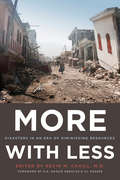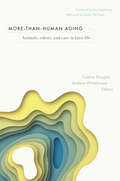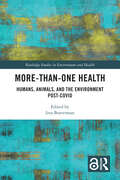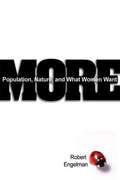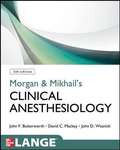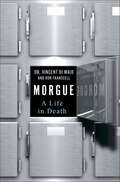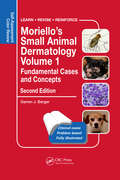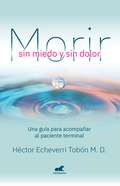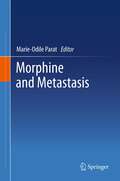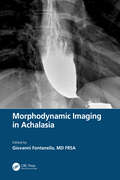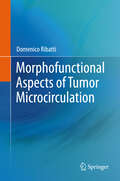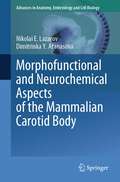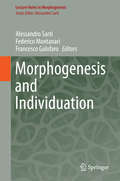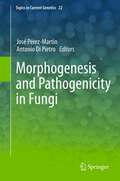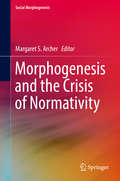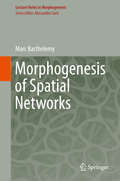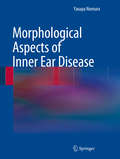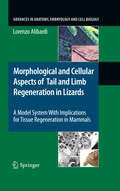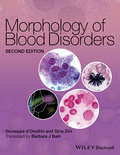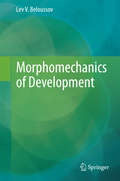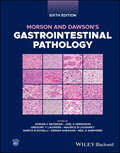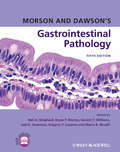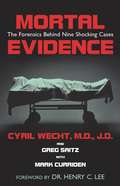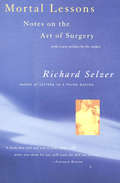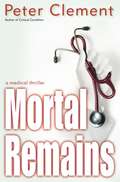- Table View
- List View
More with Less: Disasters in an Era of Diminishing Resources (International Humanitarian Affairs)
by Kevin M. CahillNatural and human-made disasters are increasing around the world. Hurricanes, typhoons, earthquakes, tsunamis, droughts, and resultant famine, floods, and armed conflicts are constant reminders of the frailty of our human race. Global warming may cause whole island states to be submerged as the oceans rise. In the past these acute and recurring crises have been met by the international community responding to UN andmedia appeals. The economic collapse of nations is now a reality; some of those most affected had been traditional, generous donors to disaster relief operations. It is unlikely—probably impossible—that they will beable to continue to contribute overseas when their own domestic needs are unmet.A recent New York Times front page report suggested that one of the few domestic issues to have bipartisan support was to cut the foreign aid budget. This book analyzes the global economic forecast and the UnitedNations pattern of philanthropy, provides a case study of how one nation with a tradition of giving will cope in the face of a marked reduction in flexible funds and then provides thoughtful chapters on new approachesto disaster preparedness and disaster response.
More-than-Human Aging: Animals, Robots, and Care in Later Life (Global Perspectives on Aging)
by Andrew Whitehouse Cristina DouglasWhat does later life look like when it is lived in the companionship of other species? Similarly, how do other species age (or not) with humans, and what sort of (a)symmetries, if any, are brought to light around how we understand and think about aging? So far, aging has been investigated in the social sciences in purely human terms. This is the first collection of original work that considers aging as taking place in relation to other species. This volume aims to start a conversation about aging by taking its more-than-human participants seriously—that is, not only as a support for or context of human aging but also, more symmetrically, as agents and subjects in the process of aging. The contributors draw upon richly descriptive ethnographic accounts, including moments of connection between seniors and dogs in a long-term care facility, human care for aging laboratory animals, and robotic companionship in later life. The ethnographies in this volume not only enrich our understanding of more-than-human companionship during the human aging process but also challenge and urge us to rethink what it means to live later in life in ecologically entangled social and moral worlds.
More-than-One Health: Humans, Animals, and the Environment Post-COVID (Routledge Studies in Environment and Health)
by Irus BravermanThis edited volume examines the complex entanglements of human, animal, and environmental health. It assembles leading scholars from the humanities, social sciences, natural sciences, and medicine to explore existing One Health approaches and to envision a mode of health that is both more-than-human and also more sensitive to, and explicit about, colonial and neocolonial legacies—urging the decolonization of One Health. While acknowledging the importance of One Health, the volume at the same time critically examines its roots, highlighting the structural biases and power dynamics still at play in this global health regime. The volume is distinctive in its geographic breadth. It travels from Inuit sled dogs in the Arctic to rock hyraxes in Jerusalem, from black-faced spoonbills in Taiwan to street dogs in India, from spittle-bugs on Mallorca’s almond trees to jellyfish management at sea, and from rabies in sub-Saharan Africa to massive culling practices in South Korea. Together, the contributors call for One Health to move toward a more transparent, plural, and just perception of health that takes seriously the role of more-than-humans and of nonscientific knowledges, pointing to ways in which One Health can—and should—be decolonized. This volume will appeal to researchers and practitioners in the medical humanities, posthumanities, environmental humanities, science and technology studies, animal studies, multispecies ethnography, anthrozoology, and critical public health.
More: Population, Nature and What Women Want
by Robert EngelmanIn the capital of Ghana, a teenager nicknamed "Condom Sister" trolls the streets to educate other young people about contraception. Her work and her own aspirations point to a remarkable shift not only in the West African nation, where just a few decades ago women had nearly seven children on average, but around the globe. While world population continues to grow, family size keeps dropping in countries as diverse as Switzerland and South Africa. The phenomenon has some lamenting the imminent extinction of humanity, while others warn that our numbers will soon outgrow the planet's resources. Robert Engelman offers a decidedly different vision--one that celebrates womens' widespread desire for smaller families. Mothers aren't seeking more children, he argues, but more for their children. If they're able to realize their intentions, we just might suffer less climate change, hunger, and disease, not to mention sky-high housing costs and infuriating traffic jams. In More, Engelman shows that this three-way dance between population, womens' autonomy, and the natural world is as old as humanity itself. He traces pivotal developments in our history that set population--and society--on its current trajectory, from hominids' first steps on two feet to the persecution of 'witches' in Europe to the creation of modern contraception. Both personal and sweeping, More explores how population growth has shaped modern civilization --and humanity as we know it. The result is a mind-stretching exploration of parenthood, sex, and culture through the ages. Yet for all its fascinating historical detail, More is primarily about the choices we face today. Whether society supports women to have children when and only when they choose to will not only shape their lives, but the world all our children will inherit.
Morgan & Mikhail's Clinical Anesthesiology Fifth Edition
by John F. Butterworth David C. Mackey John D. WasnickCurrent, concise, and engagingly written, Morgan & Mikhail’s Clinical Anesthesiology, Fifth Edition is a true essential for all anesthesia students and practitioners. This trusted classic delivers comprehensive coverage of the field’s must-know basic science and clinical topics in a clear, easy-to-understand presentation. Indispensable for coursework, exam review, and as a clinical refresher, this trusted text has been extensively updated to reflect the latest research and developments.
Morgue: A Life in Death
by Ron Franscell Vincent Di MaioIn this clear-eyed, gritty, and enthralling narrative, Dr. Vincent Di Maio and veteran crime writer Ron Franscell guide us behind the morgue doors to tell a fascinating life story through the cases that have made DiMaio famous--from the exhumation of assassin Lee Harvey Oswald to the complex issues in the shooting of Florida teenager Trayvon Martin. Beginning with his street-smart Italian origins in Brooklyn, the book spans 40 years of work and more than 9,000 autopsies, and Di Maio's eventual rise into the pantheon of forensic scientists. One of the country's most methodical and intuitive criminal pathologists will dissect himself, maintaining a nearly continuous flow of suspenseful stories, revealing anecdotes, and enough macabre insider details to rivet the most fervent crime fans.
Moriello's Small Animal Dermatology Volume 1, Fundamental Cases and Concepts: Self-Assessment Color Review, Second Edition (Veterinary Self-Assessment Color Review Series)
by Darren BergerKaren Moriello's seminal book has been completely updated in an effort to create a true two-volume set highlighting fundamental and advanced concepts. This revised fundamental edition includes all new cases and nearly 300 new images. The guide uses a case-based format to deliver a general overview of dermatology of the dog and cat, providing a reference that mirrors the way veterinarians will encounter different scenarios at random in real-life practice. It uses self-assessment problems to review the most common skin diseases encountered every day, plus some more obscure diseases that a veterinarian will face.
Morir sin miedo y sin dolor: Una guía para acompañar al paciente terminal
by Hector Echeverri TobonUn libro para que el acompañante del paciente terminal encuentre esperanza, consuelo y una guía para acercarse a la muerte desde otra perspectiva. <P><P>Cuando un ser humano es declarado como un "paciente terminal" sufre un enorme impacto emocional y se desatan en él toda suerte de procesos físicos, psicológicos y psíquicos. Por ello, requiere comprensión, honestidad, compañía y atención sin límites de sus familiares y seres queridos, pero ellos también se hallan bajo el profundo efecto de esta noticia. <P><P>Es un momento difícil para todos en el que, sin importar las buenas intenciones, se suelen cometer graves errores que lesionan la unidad familiar, le generan al paciente un malestar innecesario y convierten la despedida más importante de su vida en un momento de angustia y dolor. <P><P> El doctor Héctor Echeverri Tobón, después de haber acompañado en sus últimos días a más de doscientos pacientes terminales, comparte en este libro sus enseñanzas y aprendizajes, un cúmulo de conocimientos en los que se vislumbra una ruta para acompañar al buen morir y para entender la muerte desde una perspectiva más natural.
Morphine and Metastasis
by Marie-Odile ParatThis book would combine chapters written by the most qualified authors around the world whose research encompasses the effect of morphine or other opioids on tumor growth and metastasis. This includes clinicians involved in trials determining which type of post surgical pain management can minimize the risk of recurrence or metastasis, researchers working on animal models and studying the effect of morphine on tumors, and most importantly the mechanism for this effect, and lastly cell biologists. There is currently a lot of research going on trying to reconcile the pro- and anti-cancer aspects of opioids actions.
Morphodynamic Imaging in Achalasia
by Giovanni FontanellaThis book embarks on a journey never taken before, approaching the imaging of the disease of achalasia with new pathophysiological assumptions in mind, coming from the Chicago Classification of Manometric diagnosis. Using state-of-the-art, modern x-ray technology, the authors have developed a schematic and simple approach to detection, diagnosis, and patient stadiation and prognostic stratification, for radiologists, clinicians, and students. Key Features: 1. Serves as a useful guide to structured and comprehensive reporting of barium swallows, both in achalasia and other oesophageal motility disorders. 2. Allows radiologists, both specialists, and trainees, to comprehensively understand achalasia from anatomic, pathophysiologic, therapeutic points of view, allowing for exact comprehension, detection, and reporting of the radiologic hallmarks of the disease. 3. Empowers readers to diagnose and define the exact achalasia subtype in each patient, due to the specifically developed FBF score.
Morphofunctional Aspects of Tumor Microcirculation
by Domenico RibattiBlood vessels of tumors display many structural and functional abnormalities. Their unusual leakiness, potential for rapid growth and remodeling, and expression of distinctive surface molecules mediate the dissemination of tumor cells in the bloodstream and maintain the tumor microenvironment. Like normal blood vessels, they consist of endothelial cells, mural cells and their enveloping basement membrane. Common features, irrespective of their origin, size and growth pattern, are absent hierarchy, formation of large-caliber sinusoidal vessels, markedly heterogeneous density, increased permeability, decreased and abnormal pericyte-endothelial cell adhesion, irregular basement membrane structure, and the incorporation of bone-marrow-derived endothelial progenitor cells in the microvasculature. A number of specific tumor endothelial markers have been identified, as well as chromosomal abnormalities. These markers may be used to deliver drugs specifically and selectively to the tumor microvasculature.
Morphofunctional and Neurochemical Aspects of the Mammalian Carotid Body (Advances in Anatomy, Embryology and Cell Biology #237)
by Nikolai E. Lazarov Dimitrinka Y. AtanasovaThis new volume of the book series Advances in Anatomy, Embryology and Cell Biology provides a complete and exhaustive overview of the morphofunctional organization of the mammalian carotid body, a polymodal chemosensory organ responsible for the maintenance of blood gas homeostasis. The authors review the state of the art of the neurochemical anatomy of carotid body´s cell populations with a special reference to their structural and neurochemical plasticity. The essential role of this organ in the generation, progression and maintenance of cardiorespiratory and metabolic diseases in humans and other mammals is presented. Finally, the book summarizes current knowledge on the stem cell niche in the mammalian carotid body and discusses its contribution to replacement cell therapy and other potential applications in translational research. This book represents an essential reading for physiologists, anatomists, cell, and developmental biologists, as well as physicians, veterinarians, and biomedical researchers.
Morphogenesis and Individuation
by Alessandro Sarti Federico Montanari Francesco GalofaroThis contributed volume aims to reconsider the concept of individuation, clarifying its articulation with respect to contemporary problems in perceptual, neural, developmental, semiotic and social morphogenesis. The authors approach the ontogenetical issue by taking into account the morphogenetic process, involving the concept of individuation proposed by Gilbert Simondon and Gilles Deleuze. The target audience primarily comprises experts in the field but the book may also be beneficial for graduate students. The challenge of the genesis and constitution of "units" has always been at the center of philosophical and scientific research. This ontogenetical issue is common to every discipline but it is articulated in different ways: in phenomenology of perception the constitution of perceptual units is at the base of gestalt field theories, in theoretical neuroscience synchronized neural assemblies are considered as correlates of conscious processes, in developmental embryogenesis the constitution of organs is the principle outcome of morphodynamic evolution while in social morphogenesis the constitution of coherent units is common to segmentary, gerarchic and functional differentiation.
Morphogenesis and Pathogenicity in Fungi
by José Pérez Martín Antonio Di PietroInfectious fungal diseases continue to take their toll in terms of human suffering and enormous economic losses. Invasive infections by opportunistic fungal pathogens are a major cause of morbidity and mortality in immuno-compromised individuals. At the same time, plant pathogenic fungi have devastating effects on crop production and human health. New strategies for antifungal control are required to meet the challenges posed by these agents, and such approaches can only be developed through the identification of novel biochemical and molecular targets. However, in contrast to bacterial pathogens, fungi display a wealth of "lifestyles" and modes of infection. This diversity makes it extremely difficult to identify individual, evolutionarily conserved virulence determinants and represents a major stumbling block in the search for common antifungal targets. In order to activate the infection programme, all fungal pathogens must undergo appropriate developmental transitions that involve cellular differentiation and the introduction of a new morphogenetic programme. How growth, cell cycle progression and morphogenesis are co-ordinately regulated during development has been an active area of research in fungal model systems such as budding and fission yeast. By contrast, we have only limited knowledge of how these developmental processes shape fungal pathogenicity, or of the role of the cell cycle and morphogenesis regulators as true virulence factors. This book combines state-of-the-art expertise from diverse pathogen model systems to update our current understanding of the regulation of fungal morphogenesis as a key determinant of pathogenicity in fungi.
Morphogenesis and the Crisis of Normativity
by Margaret S. ArcherThis volume explores the development and consequences of morphogenesis on normative regulation. It starts out by describing the great normative transformations from morphostasis, as the precondition of a harmonious relationship between legal validity and normative consensus in society, to morphogenesis, which tends to strongly undermine existing laws, norms, rules, rights and obligations because of the new variety it introduces. Next, it studies the decline of normative consensus resulting from the changes in the social contexts that made previous forms of normativity, based upon 'habits, 'habitus' and 'routine action', unhelpfully misleading because they no longer constituted relevant guidelines to action. It shows how this led to the 'Reflexive Imperative' with subjects having to work out their own purposeful actions in relation to their objective social circumstances and their personal concerns, if they were to be active rather than passive agents. Finally, the book analyses what makes for chance in normativity, and what will underwrite future social regulation. It discusses whether it is possible to establish a new corpus of laws, norms and rules, given that intense morphogenesis denies the durability of any new stable context.
Morphogenesis of Spatial Networks
by Marc BarthelemyThis book develops a morphodynamical approach of urban networks with a particular emphasis on infrastructure networks such as streets, roads and transportation networks (subway, train). The authors present the mathematical tools needed to characterize these structures and how they evolve in time. The book discusses the most important empirical results and stylized facts, and will present the most important modeling approaches. The target audience primarily comprises research experts in the field, but the book may also be beneficial for graduate students.
Morphological Aspects of Inner Ear Disease
by Yasuya NomuraThis book approaches inner ear diseases from a perspective that is as multifaceted as the diseases themselves. Common among these disorders are sudden deafness, Ménière's disease, and perilymphatic fistula. With an awareness of the generally insufficient understanding of the causes and etiologies of these and other inner ear diseases, the author helps to fill those gaps in knowledge. Several factors have impeded a clearer understanding of inner ear diseases, chiefly the small size of the organ and its location in the hard temporal bone and, consequently, the inadequate resolution of CT and MRI images for pathophysiological analysis. This book provides morphological information about the inner ear, elucidating its fluids and blood vessels to help familiarize the reader with the complicated inner ear structures. Important information about how the inner ear responds to various stimuli is also given for a better understanding of the characteristics of the organ. Included are chapters describing specific diseases and animal models of the diseases. Examples and illustrations are presented for surgical applications. For instance, patients with intractable vertigo of inner-ear origin require surgical treatment and the application of a laser to the vestibular labyrinth, described in detail. With its generous use of color photographs, this book is an excellent reference text for all doctors and trainees in the field of otolaryngology.
Morphological and Cellular Aspects of Tail and Limb Regeneration in Lizards
by Lorenzo AlibardiThe present review deals with the analysis of the cytological processess occurring during tissue regeneration in the tail and limb of lizards. These reptiles are considered as a model to understand the process of tissue regeneration in all amniotes. The review begins with some evolutive considerations on the origin of tail regeneration in comparison to the failure of limb regeneration, a unique case among amniotes. The formation of the tail in the embryo and the possible accumulation of stem cells in autotomous planes of the tail are discussed. The histological and ultrastructural processess occuring during blastema formation and tail regeneration and during limb cicatrization are presented. The comparison stresses the scarse to absent inflammatory reaction present in the tail vs the massive inflammatory response in the limb leading to scarring. In fact the experimental induction of a strong inflammation in the tail also leads to scarring. The importance of the nervous system in stimulating tail regeneration in lizards is emphasized. The presence of growth factors and extracellular matrix proteins during wound healing of the tail and limb is introduced. The review concludes stressing the importance of the lizard model of tissue regeneration for medical studies and applications.
Morphology of Blood Disorders
by Giuseppe d'Onofrio Gina ZiniMorphology of Blood Disorders, 2nd edition is an outstanding atlas with over 800 high-quality digital images, covering the whole spectrum of blood and bone marrow morphology, with particular emphasis on malignant haematology. Originally written in the Italian language by two world leaders in the field, the book has been expertly translated by the renowned haematologist and teacher, Barbara Bain. This book explores the major topics of haematological pathology, blending classical teaching with up-to-date WHO classification and terminology. Each image in this book is derived from material obtained for diagnostic purposes from patients with serious haematological conditions. Morphological details are supplemented by detailed descriptions of the output and role of automated instruments in disorders of the blood. Morphology of Blood Disorders, 2nd edition is an essential reference source for diagnosis in the haematology laboratory, designed to be the go-to guide for anyone with an interest in blood cell morphology.
Morphomechanics of Development
by Lev V. BeloussovThis book outlines a unified theory of embryonic development, assuming morphogenesis to be a multi-level process including self-organizing steps while also obeying general laws. It is shown how molecular mechanisms generate mechanical forces, which in the long run lead to morphological changes. Questions such as how stress-mediated feedback acts at the cellular and supra-cellular levels and how executive and regulatory mechanisms are mutually dependent are addressed, while aspects of collective cell behavior and the morphogenesis of plants are also discussed. The morphomechanical approach employed in the book is based on the general principles of self-organization theory.
Morson and Dawson's Gastrointestinal Pathology
by Kieran Sheahan Adrian C Bateman Joel K Greenson Gregory Y Lauwers Maurice B Loughrey Marco R Novelli Neil A ShepherdThe gold standard in gastrointestinal pathology textbooks returns More than 34 million Americans suffer from pathologies of the digestive system, with over 20 million of these disorders chronic. Treatment of these patients is a complex multidisciplinary area of clinical medicine, drawing upon expertise not only from specialist gastroenterologists but also pathologists, immunologists, endoscopists, and more. Morson & Dawson’s Gastrointestinal Pathology has long set the standard for pathology textbooks, with its distinctive balance of clinical gastroenterology and pathology. Now fully updated to reflect the latest research in this vital field of medicine, it promises to bring this subject to a new generation of clinicians and pathologists worldwide. Readers of the sixth edition of Morson and Dawson’s Gastrointestinal Pathology will also find: Contemporary recommendations and guidelines for getting the most out of every pathology specimen and producing the best possible report for managing the patientDiscussions of the evolving applications of immunohistochemistry and in situ hybridisationA completely new chapter on lymphoid and other tumours of the large intestine Morson & Dawson’s Gastrointestinal Pathology is ideal for gastrointestinal pathologists, general pathologists, gastroenterologists, and any clinicians who work with or in gastrointestinal practice.
Morson and Dawson's Gastrointestinal Pathology
by Neil A. Shepherd Bryan F. Warren Geraint T. Williams Joel K. Greenson Gregory Y. Lauwers Marco R. NovelliThis new edition of the classic gastrointestinal pathology text once again provides pathologists and gastroenterologists with a comprehensive reference tool. The pathology of the GI tract is reviewed in sections according to each anatomical part of the body, with the goal of aiding the gastroenterologist in his/her clinical decision making when treating patients.
Mortal Evidence: The Forensics Behind Nine Shocking Cases
by Cyril H. WechtA lifeless newborn baby is found discarded in a motel Dumpster. Authorities quickly arrest the infant's teenage parents, charging them with murder. Did Amy Grossberg and Brian Peterson, in fact, murder their own baby? Tammy Wynette died suddenly at a relatively young age, and yet no autopsy was performed? Was someone trying to hide the real cause of death? Did Sam Sheppard (later dubbed "The Fugitive" based on a television series) really kill his wife? And if not, who committed the murder?Things are not always as they appear, as world-renowned forensic pathologist Dr. Cyril Wecht shows in this riveting behind-the-scenes look at nine famous cases. In the nationally known baby case involving Amy Grossberg and Brian Peterson, Dr. Wecht reviews the evidence and comes to a startling conclusion. In fascinating detail, he demonstrates how the tools of forensic pathology often uncover murky, long-hidden secrets that crack seemingly unsolvable crimes. Writing in the first-person Dr. Wecht leads you into the heart of the investigation, focusing each chapter on a single engrossing drama. He reveals the most startling evidence that shows why JonBenet Ramsey's killer most likely came from within her home, why O.J. Simpson probably had an accomplice in the murder of Nicole Simpson and Ron Goldman, shocking revelations about Robert Berdella's grisly torture and sex-abuse crimes against young men, and many intriguing facts about other infamous cases.If you find the fictional plots of such dramas as C.S.I. exciting, you will be amazed by the true stories told by Dr. Wecht, with the help of two top-flight veteran reporters, Greg Saitz and Mark Curriden, in this amazing real-life thriller. As this intriguing page-turner proves, the science of forensic pathology has changed the face of detective work forever.
Mortal Lessons: Notes on the Art of Surgery
by Richard SelzerA surgeon shares true stories of life, death, and the human body in an essay collection that &“will nail you to your chair&” (Saturday Review). With settings ranging from the operating theater to a Korean ambulance, and topics as varied as the disposition of a corpse and the author&’s own childhood, these nineteen captivating, wry, and intimate vignettes offer a poignant examination of health, humanity, and, of course, mortality. Sometimes tragic, sometimes humorous, the essays offer a physician&’s viewpoint that goes beyond the medical to also consider the most meaningful issues and questions we face, whether as doctors or patients, cared for or caregiver. Praised by Kirkus Reviews as &“an impressive display of knowledge and art, magic and mystery,&” Mortal Lessons is a classic reflection on the human body and the human experience, and will resonate with readers for generations to come.
Mortal Remains (Dr. Earl Garnet #4)
by Peter ClementIn a small upstate New York town, an idyllic lake yields a ghastly discovery when the skeletal remains of a young woman missing for twenty-seven years are pulled from the icy depths--along with unmistakable evidence of her murder. Suddenly, the long-dormant case of Kelly McShane Braden's mysterious disappearance is reactivated. And for two devastated men, dark emotions and disturbing secrets will also rise to the surface. For local coroner Dr. Mark Roper, the murder is more than just a grim interruption of his general practice in sleepy Hampton Junction. Kelly Braden had been a surrogate sister. When the police insist the trail of Kelly's disappearance is too cold to pick up again, he vows to find the missing pieces of the past that will lead him to a killer. Because that's what cracks cold cases: "One guy who can't get it out of his head. " Yet Mark isn't the only one with Kelly's murder on his mind. Dr. Earl Garnet, chief of staff at Buffalo's St. Paul's Hospital, was once Kelly's secret lover . . . and would-be savior. Until his plans to rescue her from an abusive marriage were cut short by her vanishing. Now, as the last person to see Kelly alive, he's in danger of becoming the prime suspect, unless he can unmask the murderer first. But neither man knows about the twisted chain of lies and corruption that led to Kelly's death--or the shocking revelations that were meant to go with her to a watery grave. And the harder they push for answers, the easier they make it for their lethal quarry to zero in on them--and push back with deadly force. WithMortal Remains, Peter Clement remains in total control of readers' nerves from the very first page, once more wielding heart-racing suspense and scalpel-sharp terror with a master surgeon's skill. From the Hardcover edition.
